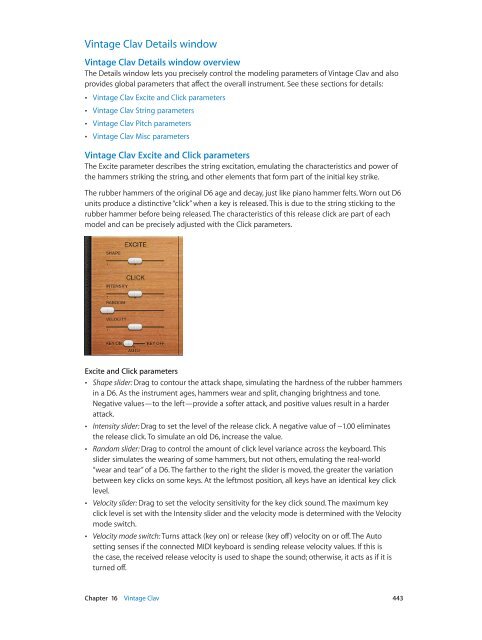Apple MainStage 3 Instruments - MainStage 3 Instruments
Apple MainStage 3 Instruments - MainStage 3 Instruments
Apple MainStage 3 Instruments - MainStage 3 Instruments
You also want an ePaper? Increase the reach of your titles
YUMPU automatically turns print PDFs into web optimized ePapers that Google loves.
Vintage Clav Details window<br />
Vintage Clav Details window overview<br />
The Details window lets you precisely control the modeling parameters of Vintage Clav and also<br />
provides global parameters that affect the overall instrument. See these sections for details:<br />
••<br />
Vintage Clav Excite and Click parameters<br />
••<br />
Vintage Clav String parameters<br />
••<br />
Vintage Clav Pitch parameters<br />
••<br />
Vintage Clav Misc parameters<br />
Vintage Clav Excite and Click parameters<br />
The Excite parameter describes the string excitation, emulating the characteristics and power of<br />
the hammers striking the string, and other elements that form part of the initial key strike.<br />
The rubber hammers of the original D6 age and decay, just like piano hammer felts. Worn out D6<br />
units produce a distinctive “click” when a key is released. This is due to the string sticking to the<br />
rubber hammer before being released. The characteristics of this release click are part of each<br />
model and can be precisely adjusted with the Click parameters.<br />
Excite and Click parameters<br />
••<br />
Shape slider: Drag to contour the attack shape, simulating the hardness of the rubber hammers<br />
in a D6. As the instrument ages, hammers wear and split, changing brightness and tone.<br />
Negative values—to the left—provide a softer attack, and positive values result in a harder<br />
attack.<br />
••<br />
Intensity slider: Drag to set the level of the release click. A negative value of −1.00 eliminates<br />
the release click. To simulate an old D6, increase the value.<br />
••<br />
Random slider: Drag to control the amount of click level variance across the keyboard. This<br />
slider simulates the wearing of some hammers, but not others, emulating the real-world<br />
“wear and tear” of a D6. The farther to the right the slider is moved, the greater the variation<br />
between key clicks on some keys. At the leftmost position, all keys have an identical key click<br />
level.<br />
••<br />
Velocity slider: Drag to set the velocity sensitivity for the key click sound. The maximum key<br />
click level is set with the Intensity slider and the velocity mode is determined with the Velocity<br />
mode switch.<br />
••<br />
Velocity mode switch: Turns attack (key on) or release (key off) velocity on or off. The Auto<br />
setting senses if the connected MIDI keyboard is sending release velocity values. If this is<br />
the case, the received release velocity is used to shape the sound; otherwise, it acts as if it is<br />
turned off.<br />
Chapter 16 Vintage Clav 443
















